Analyzing Indigenous Health Service Impact: HSC203 Perspectives
VerifiedAdded on 2023/04/06
|7
|1315
|243
Report
AI Summary
This report critically analyzes an Indigenous Health Service in Australia, focusing on its impact on the health and well-being of Indigenous Australians. It highlights the poorer health outcomes and higher morbidity rates among this population due to limited access to healthcare. The report emphasizes the importance of improved healthcare access through infrastructure development in remote areas and targeted health promotion strategies to combat chronic conditions such as cardiovascular diseases and chronic kidney disease. It also discusses the significance of patient-centered care that incorporates cultural identity and beliefs. External factors like government policies and self-determination are identified as key influences. Furthermore, the report examines the impact of modern medicine and the integration of traditional practices on the health outcomes of Indigenous people. The analysis underscores the need for culturally sensitive and accessible healthcare services to improve the overall health and well-being of Indigenous Australians.
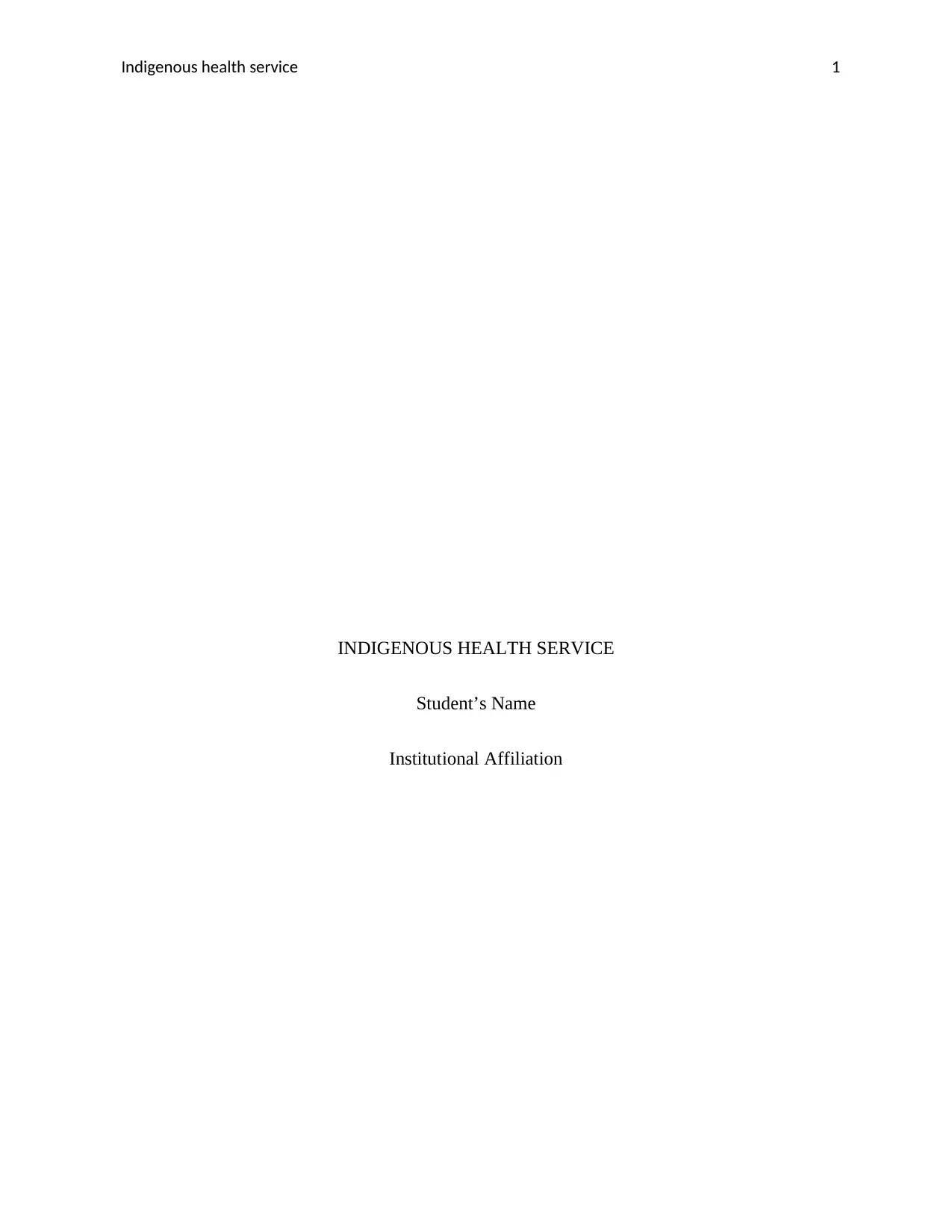
Indigenous health service 1
INDIGENOUS HEALTH SERVICE
Student’s Name
Institutional Affiliation
INDIGENOUS HEALTH SERVICE
Student’s Name
Institutional Affiliation
Paraphrase This Document
Need a fresh take? Get an instant paraphrase of this document with our AI Paraphraser
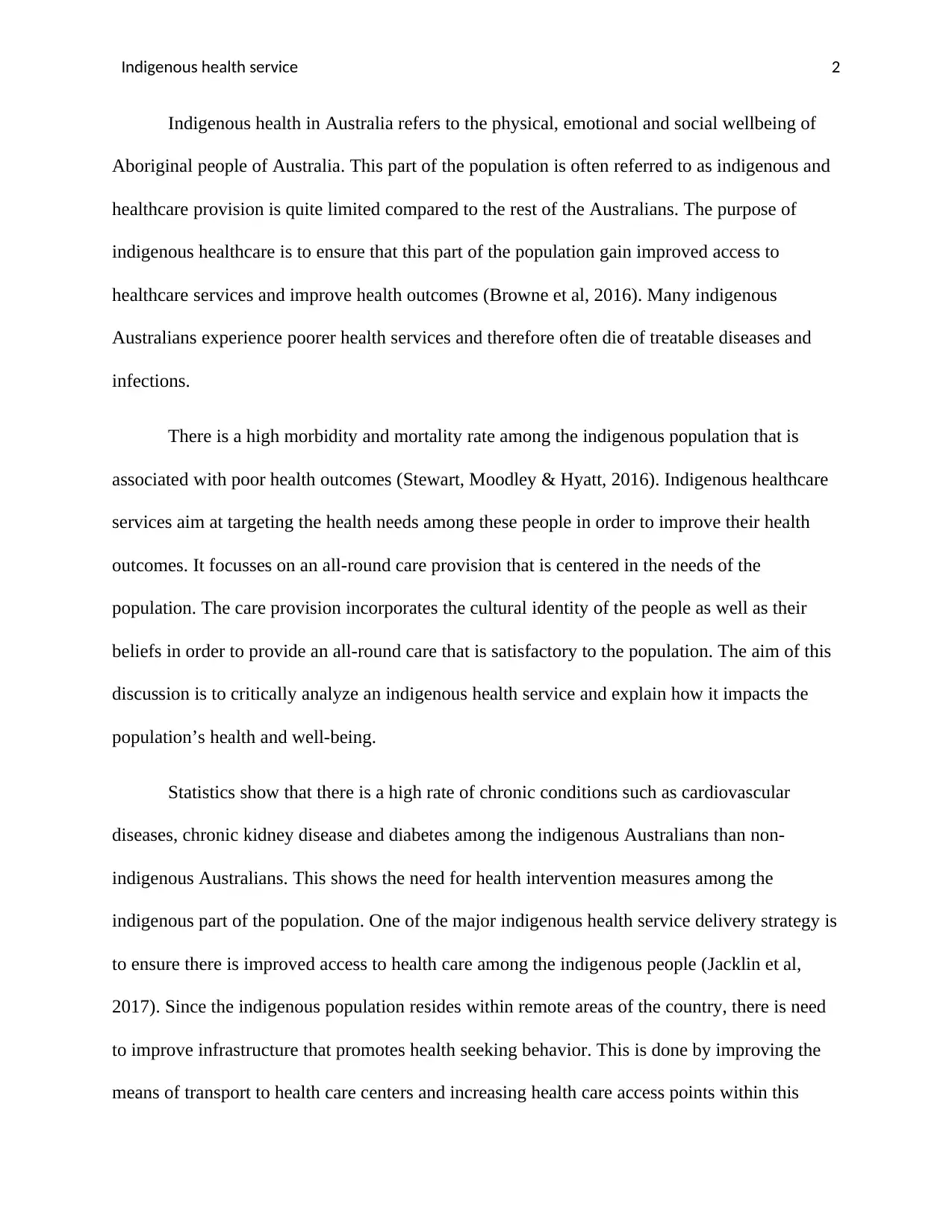
Indigenous health service 2
Indigenous health in Australia refers to the physical, emotional and social wellbeing of
Aboriginal people of Australia. This part of the population is often referred to as indigenous and
healthcare provision is quite limited compared to the rest of the Australians. The purpose of
indigenous healthcare is to ensure that this part of the population gain improved access to
healthcare services and improve health outcomes (Browne et al, 2016). Many indigenous
Australians experience poorer health services and therefore often die of treatable diseases and
infections.
There is a high morbidity and mortality rate among the indigenous population that is
associated with poor health outcomes (Stewart, Moodley & Hyatt, 2016). Indigenous healthcare
services aim at targeting the health needs among these people in order to improve their health
outcomes. It focusses on an all-round care provision that is centered in the needs of the
population. The care provision incorporates the cultural identity of the people as well as their
beliefs in order to provide an all-round care that is satisfactory to the population. The aim of this
discussion is to critically analyze an indigenous health service and explain how it impacts the
population’s health and well-being.
Statistics show that there is a high rate of chronic conditions such as cardiovascular
diseases, chronic kidney disease and diabetes among the indigenous Australians than non-
indigenous Australians. This shows the need for health intervention measures among the
indigenous part of the population. One of the major indigenous health service delivery strategy is
to ensure there is improved access to health care among the indigenous people (Jacklin et al,
2017). Since the indigenous population resides within remote areas of the country, there is need
to improve infrastructure that promotes health seeking behavior. This is done by improving the
means of transport to health care centers and increasing health care access points within this
Indigenous health in Australia refers to the physical, emotional and social wellbeing of
Aboriginal people of Australia. This part of the population is often referred to as indigenous and
healthcare provision is quite limited compared to the rest of the Australians. The purpose of
indigenous healthcare is to ensure that this part of the population gain improved access to
healthcare services and improve health outcomes (Browne et al, 2016). Many indigenous
Australians experience poorer health services and therefore often die of treatable diseases and
infections.
There is a high morbidity and mortality rate among the indigenous population that is
associated with poor health outcomes (Stewart, Moodley & Hyatt, 2016). Indigenous healthcare
services aim at targeting the health needs among these people in order to improve their health
outcomes. It focusses on an all-round care provision that is centered in the needs of the
population. The care provision incorporates the cultural identity of the people as well as their
beliefs in order to provide an all-round care that is satisfactory to the population. The aim of this
discussion is to critically analyze an indigenous health service and explain how it impacts the
population’s health and well-being.
Statistics show that there is a high rate of chronic conditions such as cardiovascular
diseases, chronic kidney disease and diabetes among the indigenous Australians than non-
indigenous Australians. This shows the need for health intervention measures among the
indigenous part of the population. One of the major indigenous health service delivery strategy is
to ensure there is improved access to health care among the indigenous people (Jacklin et al,
2017). Since the indigenous population resides within remote areas of the country, there is need
to improve infrastructure that promotes health seeking behavior. This is done by improving the
means of transport to health care centers and increasing health care access points within this
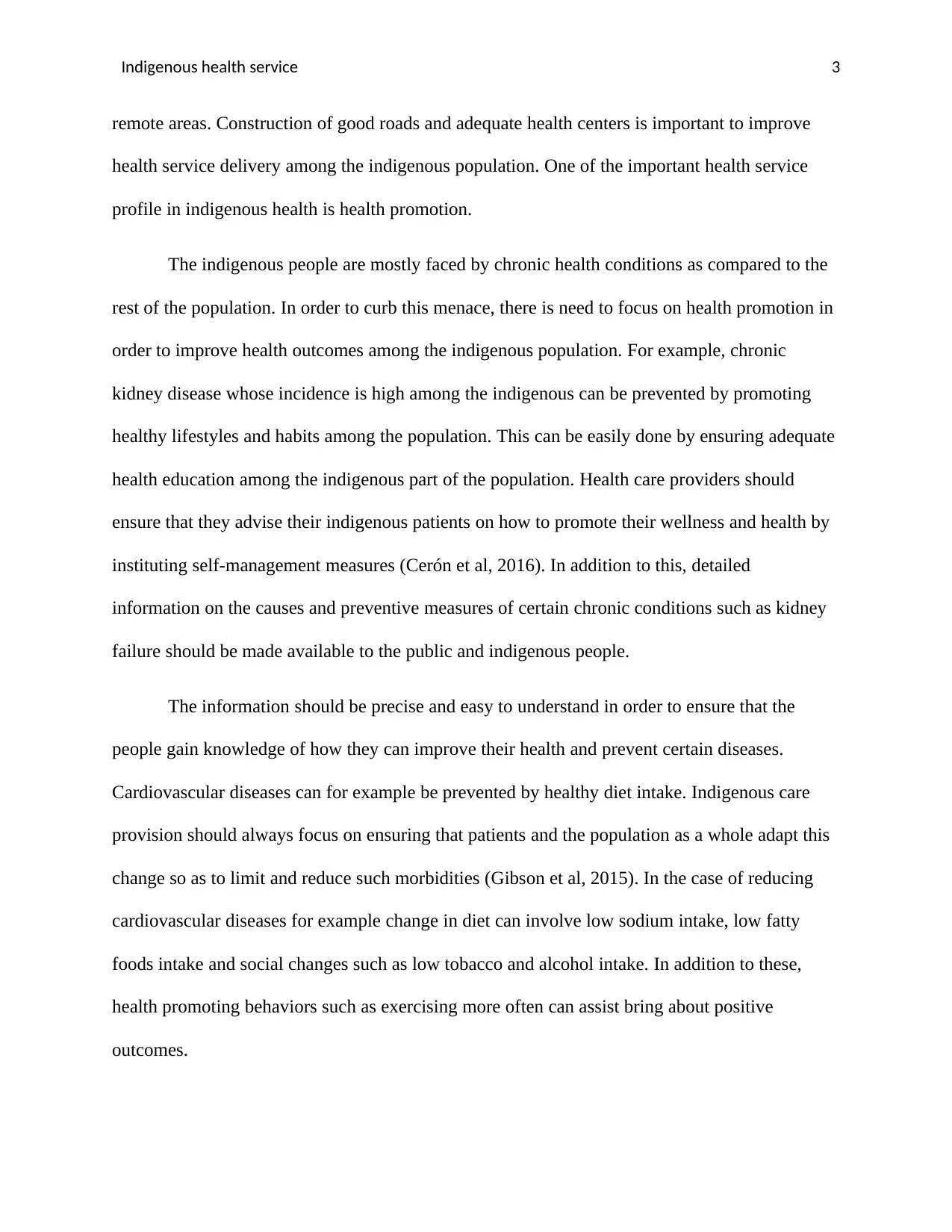
Indigenous health service 3
remote areas. Construction of good roads and adequate health centers is important to improve
health service delivery among the indigenous population. One of the important health service
profile in indigenous health is health promotion.
The indigenous people are mostly faced by chronic health conditions as compared to the
rest of the population. In order to curb this menace, there is need to focus on health promotion in
order to improve health outcomes among the indigenous population. For example, chronic
kidney disease whose incidence is high among the indigenous can be prevented by promoting
healthy lifestyles and habits among the population. This can be easily done by ensuring adequate
health education among the indigenous part of the population. Health care providers should
ensure that they advise their indigenous patients on how to promote their wellness and health by
instituting self-management measures (Cerón et al, 2016). In addition to this, detailed
information on the causes and preventive measures of certain chronic conditions such as kidney
failure should be made available to the public and indigenous people.
The information should be precise and easy to understand in order to ensure that the
people gain knowledge of how they can improve their health and prevent certain diseases.
Cardiovascular diseases can for example be prevented by healthy diet intake. Indigenous care
provision should always focus on ensuring that patients and the population as a whole adapt this
change so as to limit and reduce such morbidities (Gibson et al, 2015). In the case of reducing
cardiovascular diseases for example change in diet can involve low sodium intake, low fatty
foods intake and social changes such as low tobacco and alcohol intake. In addition to these,
health promoting behaviors such as exercising more often can assist bring about positive
outcomes.
remote areas. Construction of good roads and adequate health centers is important to improve
health service delivery among the indigenous population. One of the important health service
profile in indigenous health is health promotion.
The indigenous people are mostly faced by chronic health conditions as compared to the
rest of the population. In order to curb this menace, there is need to focus on health promotion in
order to improve health outcomes among the indigenous population. For example, chronic
kidney disease whose incidence is high among the indigenous can be prevented by promoting
healthy lifestyles and habits among the population. This can be easily done by ensuring adequate
health education among the indigenous part of the population. Health care providers should
ensure that they advise their indigenous patients on how to promote their wellness and health by
instituting self-management measures (Cerón et al, 2016). In addition to this, detailed
information on the causes and preventive measures of certain chronic conditions such as kidney
failure should be made available to the public and indigenous people.
The information should be precise and easy to understand in order to ensure that the
people gain knowledge of how they can improve their health and prevent certain diseases.
Cardiovascular diseases can for example be prevented by healthy diet intake. Indigenous care
provision should always focus on ensuring that patients and the population as a whole adapt this
change so as to limit and reduce such morbidities (Gibson et al, 2015). In the case of reducing
cardiovascular diseases for example change in diet can involve low sodium intake, low fatty
foods intake and social changes such as low tobacco and alcohol intake. In addition to these,
health promoting behaviors such as exercising more often can assist bring about positive
outcomes.
⊘ This is a preview!⊘
Do you want full access?
Subscribe today to unlock all pages.

Trusted by 1+ million students worldwide
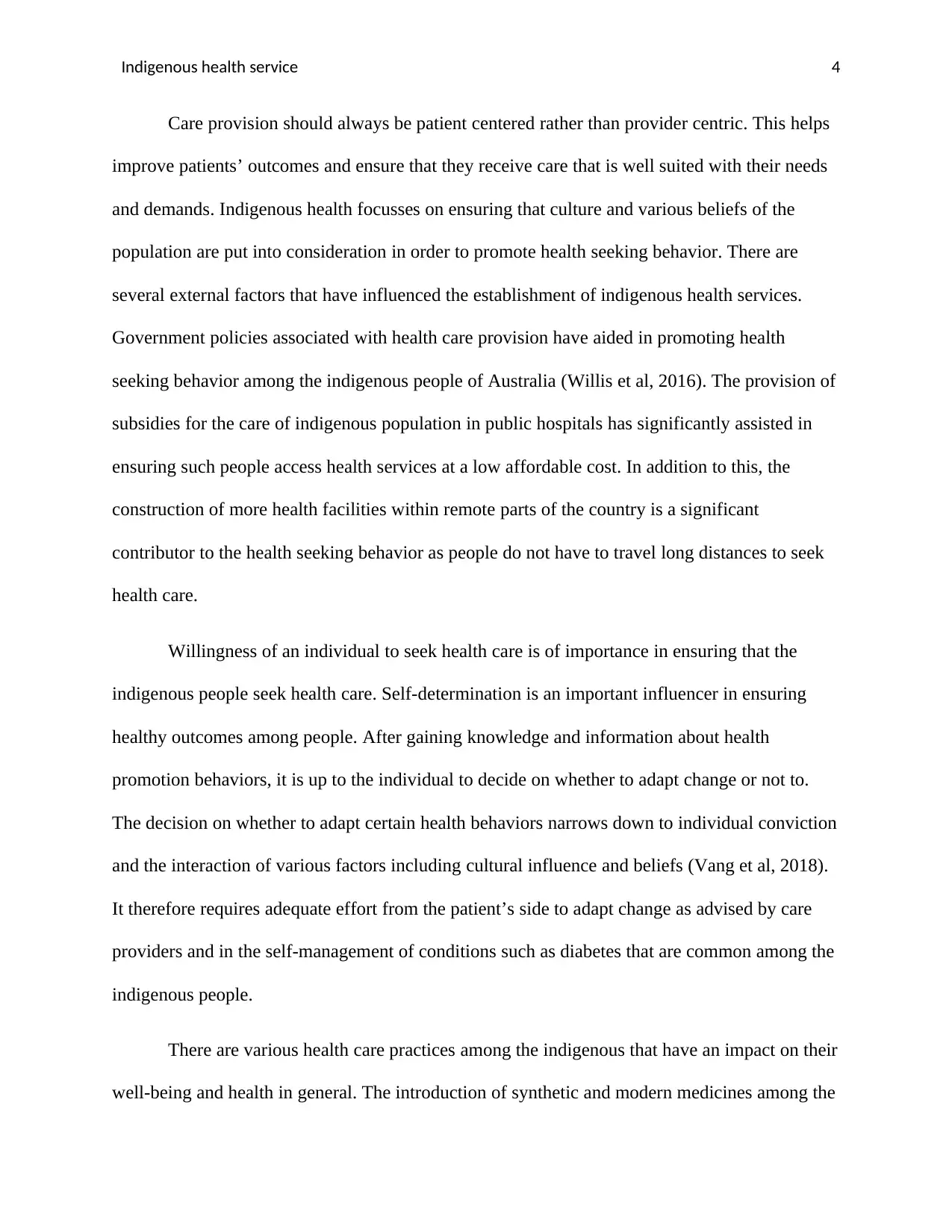
Indigenous health service 4
Care provision should always be patient centered rather than provider centric. This helps
improve patients’ outcomes and ensure that they receive care that is well suited with their needs
and demands. Indigenous health focusses on ensuring that culture and various beliefs of the
population are put into consideration in order to promote health seeking behavior. There are
several external factors that have influenced the establishment of indigenous health services.
Government policies associated with health care provision have aided in promoting health
seeking behavior among the indigenous people of Australia (Willis et al, 2016). The provision of
subsidies for the care of indigenous population in public hospitals has significantly assisted in
ensuring such people access health services at a low affordable cost. In addition to this, the
construction of more health facilities within remote parts of the country is a significant
contributor to the health seeking behavior as people do not have to travel long distances to seek
health care.
Willingness of an individual to seek health care is of importance in ensuring that the
indigenous people seek health care. Self-determination is an important influencer in ensuring
healthy outcomes among people. After gaining knowledge and information about health
promotion behaviors, it is up to the individual to decide on whether to adapt change or not to.
The decision on whether to adapt certain health behaviors narrows down to individual conviction
and the interaction of various factors including cultural influence and beliefs (Vang et al, 2018).
It therefore requires adequate effort from the patient’s side to adapt change as advised by care
providers and in the self-management of conditions such as diabetes that are common among the
indigenous people.
There are various health care practices among the indigenous that have an impact on their
well-being and health in general. The introduction of synthetic and modern medicines among the
Care provision should always be patient centered rather than provider centric. This helps
improve patients’ outcomes and ensure that they receive care that is well suited with their needs
and demands. Indigenous health focusses on ensuring that culture and various beliefs of the
population are put into consideration in order to promote health seeking behavior. There are
several external factors that have influenced the establishment of indigenous health services.
Government policies associated with health care provision have aided in promoting health
seeking behavior among the indigenous people of Australia (Willis et al, 2016). The provision of
subsidies for the care of indigenous population in public hospitals has significantly assisted in
ensuring such people access health services at a low affordable cost. In addition to this, the
construction of more health facilities within remote parts of the country is a significant
contributor to the health seeking behavior as people do not have to travel long distances to seek
health care.
Willingness of an individual to seek health care is of importance in ensuring that the
indigenous people seek health care. Self-determination is an important influencer in ensuring
healthy outcomes among people. After gaining knowledge and information about health
promotion behaviors, it is up to the individual to decide on whether to adapt change or not to.
The decision on whether to adapt certain health behaviors narrows down to individual conviction
and the interaction of various factors including cultural influence and beliefs (Vang et al, 2018).
It therefore requires adequate effort from the patient’s side to adapt change as advised by care
providers and in the self-management of conditions such as diabetes that are common among the
indigenous people.
There are various health care practices among the indigenous that have an impact on their
well-being and health in general. The introduction of synthetic and modern medicines among the
Paraphrase This Document
Need a fresh take? Get an instant paraphrase of this document with our AI Paraphraser
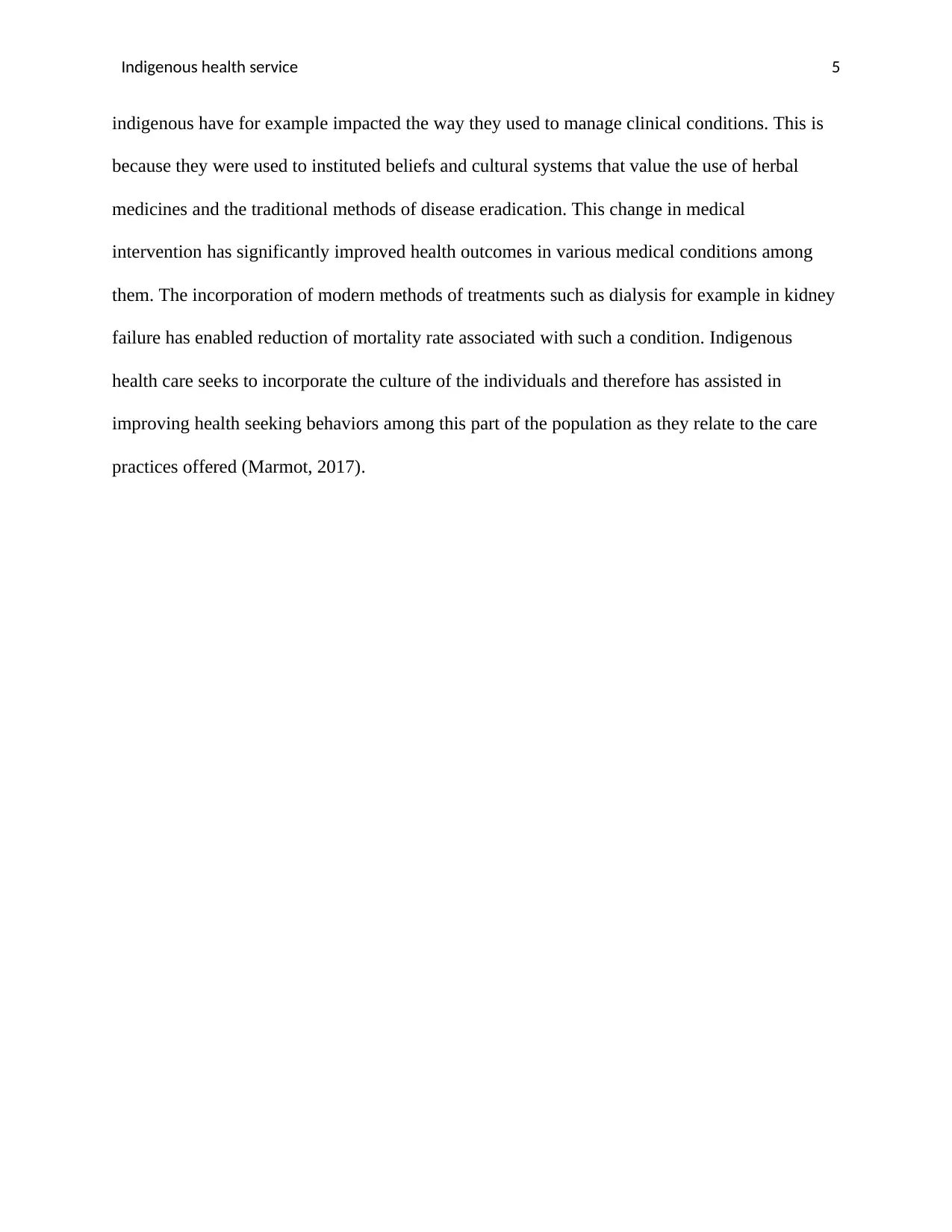
Indigenous health service 5
indigenous have for example impacted the way they used to manage clinical conditions. This is
because they were used to instituted beliefs and cultural systems that value the use of herbal
medicines and the traditional methods of disease eradication. This change in medical
intervention has significantly improved health outcomes in various medical conditions among
them. The incorporation of modern methods of treatments such as dialysis for example in kidney
failure has enabled reduction of mortality rate associated with such a condition. Indigenous
health care seeks to incorporate the culture of the individuals and therefore has assisted in
improving health seeking behaviors among this part of the population as they relate to the care
practices offered (Marmot, 2017).
indigenous have for example impacted the way they used to manage clinical conditions. This is
because they were used to instituted beliefs and cultural systems that value the use of herbal
medicines and the traditional methods of disease eradication. This change in medical
intervention has significantly improved health outcomes in various medical conditions among
them. The incorporation of modern methods of treatments such as dialysis for example in kidney
failure has enabled reduction of mortality rate associated with such a condition. Indigenous
health care seeks to incorporate the culture of the individuals and therefore has assisted in
improving health seeking behaviors among this part of the population as they relate to the care
practices offered (Marmot, 2017).
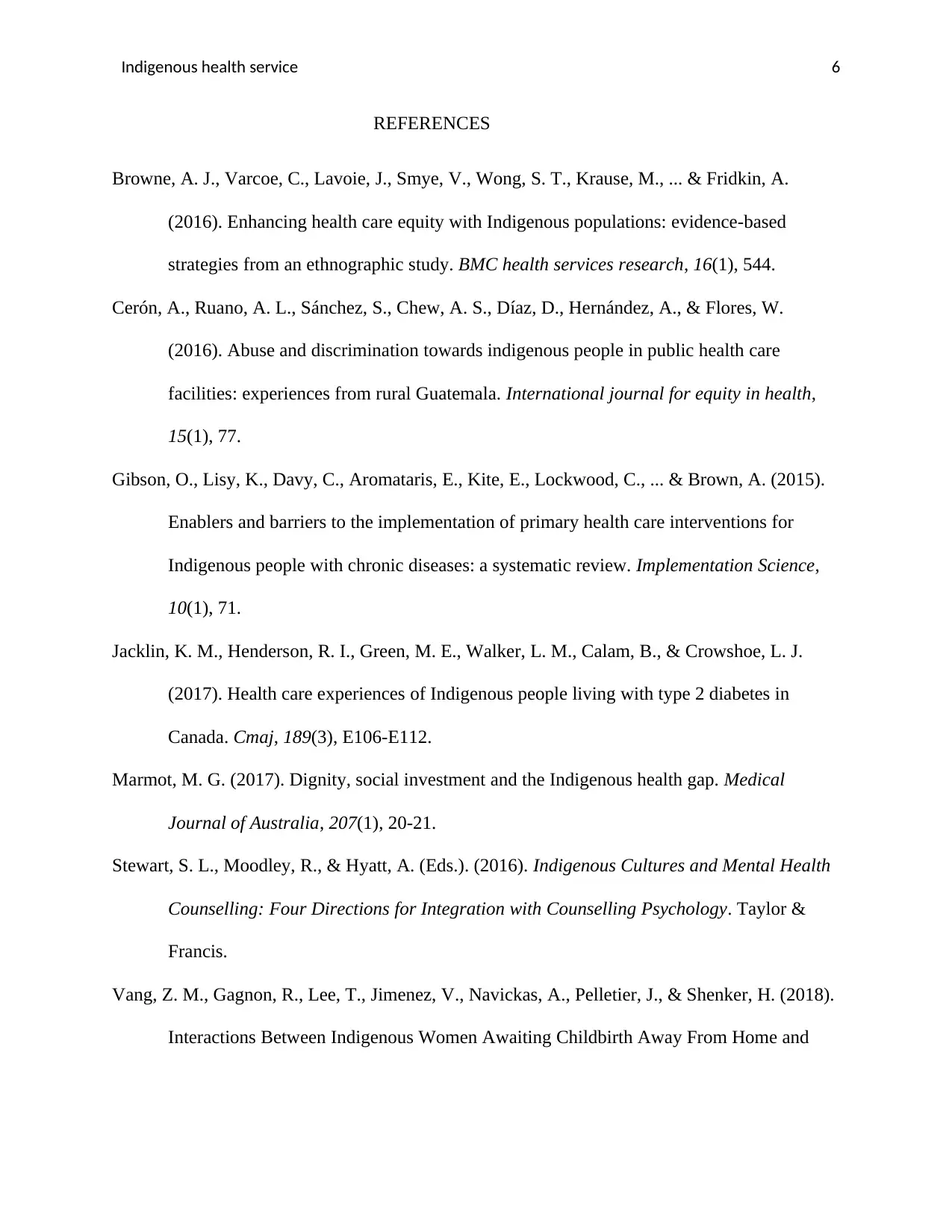
Indigenous health service 6
REFERENCES
Browne, A. J., Varcoe, C., Lavoie, J., Smye, V., Wong, S. T., Krause, M., ... & Fridkin, A.
(2016). Enhancing health care equity with Indigenous populations: evidence-based
strategies from an ethnographic study. BMC health services research, 16(1), 544.
Cerón, A., Ruano, A. L., Sánchez, S., Chew, A. S., Díaz, D., Hernández, A., & Flores, W.
(2016). Abuse and discrimination towards indigenous people in public health care
facilities: experiences from rural Guatemala. International journal for equity in health,
15(1), 77.
Gibson, O., Lisy, K., Davy, C., Aromataris, E., Kite, E., Lockwood, C., ... & Brown, A. (2015).
Enablers and barriers to the implementation of primary health care interventions for
Indigenous people with chronic diseases: a systematic review. Implementation Science,
10(1), 71.
Jacklin, K. M., Henderson, R. I., Green, M. E., Walker, L. M., Calam, B., & Crowshoe, L. J.
(2017). Health care experiences of Indigenous people living with type 2 diabetes in
Canada. Cmaj, 189(3), E106-E112.
Marmot, M. G. (2017). Dignity, social investment and the Indigenous health gap. Medical
Journal of Australia, 207(1), 20-21.
Stewart, S. L., Moodley, R., & Hyatt, A. (Eds.). (2016). Indigenous Cultures and Mental Health
Counselling: Four Directions for Integration with Counselling Psychology. Taylor &
Francis.
Vang, Z. M., Gagnon, R., Lee, T., Jimenez, V., Navickas, A., Pelletier, J., & Shenker, H. (2018).
Interactions Between Indigenous Women Awaiting Childbirth Away From Home and
REFERENCES
Browne, A. J., Varcoe, C., Lavoie, J., Smye, V., Wong, S. T., Krause, M., ... & Fridkin, A.
(2016). Enhancing health care equity with Indigenous populations: evidence-based
strategies from an ethnographic study. BMC health services research, 16(1), 544.
Cerón, A., Ruano, A. L., Sánchez, S., Chew, A. S., Díaz, D., Hernández, A., & Flores, W.
(2016). Abuse and discrimination towards indigenous people in public health care
facilities: experiences from rural Guatemala. International journal for equity in health,
15(1), 77.
Gibson, O., Lisy, K., Davy, C., Aromataris, E., Kite, E., Lockwood, C., ... & Brown, A. (2015).
Enablers and barriers to the implementation of primary health care interventions for
Indigenous people with chronic diseases: a systematic review. Implementation Science,
10(1), 71.
Jacklin, K. M., Henderson, R. I., Green, M. E., Walker, L. M., Calam, B., & Crowshoe, L. J.
(2017). Health care experiences of Indigenous people living with type 2 diabetes in
Canada. Cmaj, 189(3), E106-E112.
Marmot, M. G. (2017). Dignity, social investment and the Indigenous health gap. Medical
Journal of Australia, 207(1), 20-21.
Stewart, S. L., Moodley, R., & Hyatt, A. (Eds.). (2016). Indigenous Cultures and Mental Health
Counselling: Four Directions for Integration with Counselling Psychology. Taylor &
Francis.
Vang, Z. M., Gagnon, R., Lee, T., Jimenez, V., Navickas, A., Pelletier, J., & Shenker, H. (2018).
Interactions Between Indigenous Women Awaiting Childbirth Away From Home and
⊘ This is a preview!⊘
Do you want full access?
Subscribe today to unlock all pages.

Trusted by 1+ million students worldwide
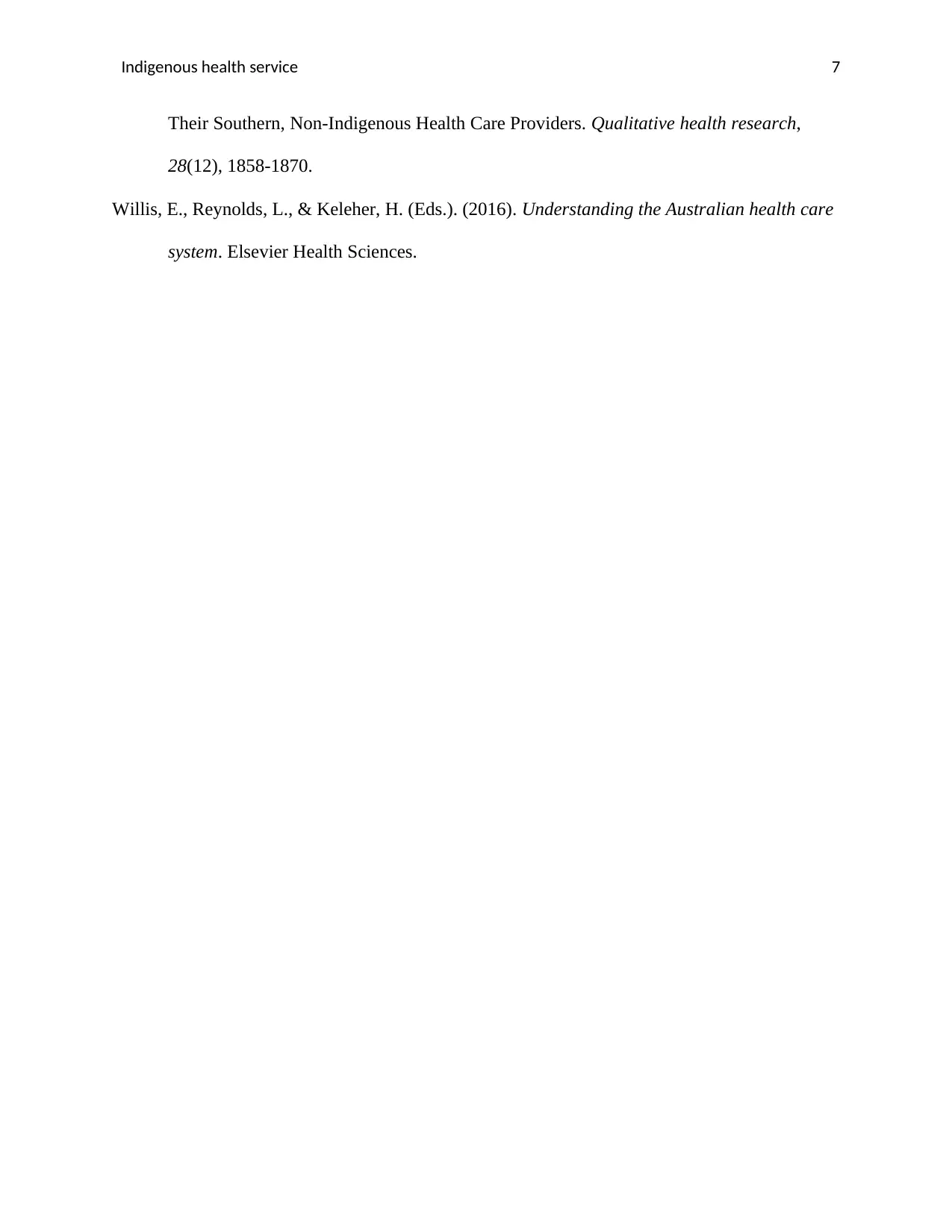
Indigenous health service 7
Their Southern, Non-Indigenous Health Care Providers. Qualitative health research,
28(12), 1858-1870.
Willis, E., Reynolds, L., & Keleher, H. (Eds.). (2016). Understanding the Australian health care
system. Elsevier Health Sciences.
Their Southern, Non-Indigenous Health Care Providers. Qualitative health research,
28(12), 1858-1870.
Willis, E., Reynolds, L., & Keleher, H. (Eds.). (2016). Understanding the Australian health care
system. Elsevier Health Sciences.
1 out of 7
Related Documents
Your All-in-One AI-Powered Toolkit for Academic Success.
+13062052269
info@desklib.com
Available 24*7 on WhatsApp / Email
![[object Object]](/_next/static/media/star-bottom.7253800d.svg)
Unlock your academic potential
Copyright © 2020–2025 A2Z Services. All Rights Reserved. Developed and managed by ZUCOL.





